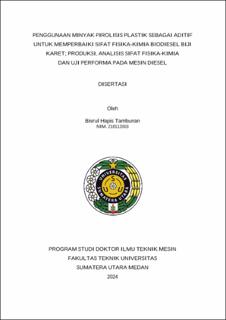| dc.description.abstract | The aim of this research is to determine the use of Pyrolysis Plastic Oil (PPO) as an additive to improve the physico-chemical properties and performance of Rubber Seed Biodiesel (RSB). In this research, BBK was produced in a double jacket reactor using a KOH catalyst according to ASTM standards. The physical and chemical properties of RSB were also examined according to ASTM standard methods. Plastic waste consisting of used oil bottles (HDPE and PET), gallon water refill caps (LDPE and HDPE), buckets and basins (PP, HDPE, LDPE, and ABS), and chopped jerry cans (HDPE) was randomly collected from the recycling site. Plastic waste is pyrolyzed in a pyrolysis reactor at a temperature of 300 oC. Plastic pyrolysis oil is pre-treated to separate the diesel and gasoline fractions. The PPO
diesel fraction was checked for its physical and chemical properties according to ASTM standards. The PPO diesel fraction is used as an additive to RSB and PPO, which are mixed with the volume %ratio: 90:10, 80:20, 70:30, and 60:40. To determine the effect of adding PPO on RSB, each mixture was examined for its physical and chemical properties. It was found that PPO can improve the physico
chemical properties of RSB, including increasing the heating value, increasing the cetane number at 10% addition, decreasing the kinematic viscosity, density, and acid value, but PPO also reduces the oxidation stability, false point, cloud point, and pour point. However, oxidation stability only decreased when adding 10% PPO, adding 20% or more did not reduce oxidation stability. A mixture of 60% RSB + 40% PPO was then used as a diesel mixture during performance testing on diesel engines. Performance test results show that the brake power of B10 and B20 is almost the same as the brake power of pure diesel, as well as BSFC and BTE, but the Brake Power and BTE of B30 and B40 are, on average, smaller than B0. On the other hand, BSFC B30 and B40 are higher than BSFC B0. In general, the exhaust gas temperature of diesel is higher than mixed fuels, but there are times when the exhaust gas temperature of B30 is higher. The opacity of diesel is between B10, B20 and B30, B40. The average HC emissions from mixed fuels are lower than
diesel. Mixed fuel CO emissions are sometimes lower and sometimes the same as diesel CO emissions. CO2 emissions from mixed fuels are lower on average than Diesel. | en_US |


